Article body copy
From the deck of a wooden fishing boat adorned with saffron, orange, and green, I squint at the point where heat waves merge with the tidal channel and blur the horizon like a greasy handprint on glass. Through the glare, four strange, dark shapes break the water’s surface—two heads, two humps.
In my mental archives, the camel has long been housed in a box stacked neatly on a shelf and left unexamined. The camel is a desert animal. The end. Its ability to stroll across a blazing arid landscape with a teetering load strapped to its back and not a single drop of water crossing its frothy lips for days is so legendary that the camel is widely known as the ship of the desert. But here, along the coastal fringes of Gujarat, India, the ships of the desert actually take to the sea.
The first two camels glide across the channel, departing a low-slung island half a kilometer from our bow, and slowly rise at the mainland shore. On knobby knees, they proceed across a broad, salt-encrusted plain. A dozen more follow. My translator, perched on a heap of fishing nets on the boat’s deck, confers with a stranger beside him. “Madame,” he then shouts over his shoulder, “there are 100 coming!”
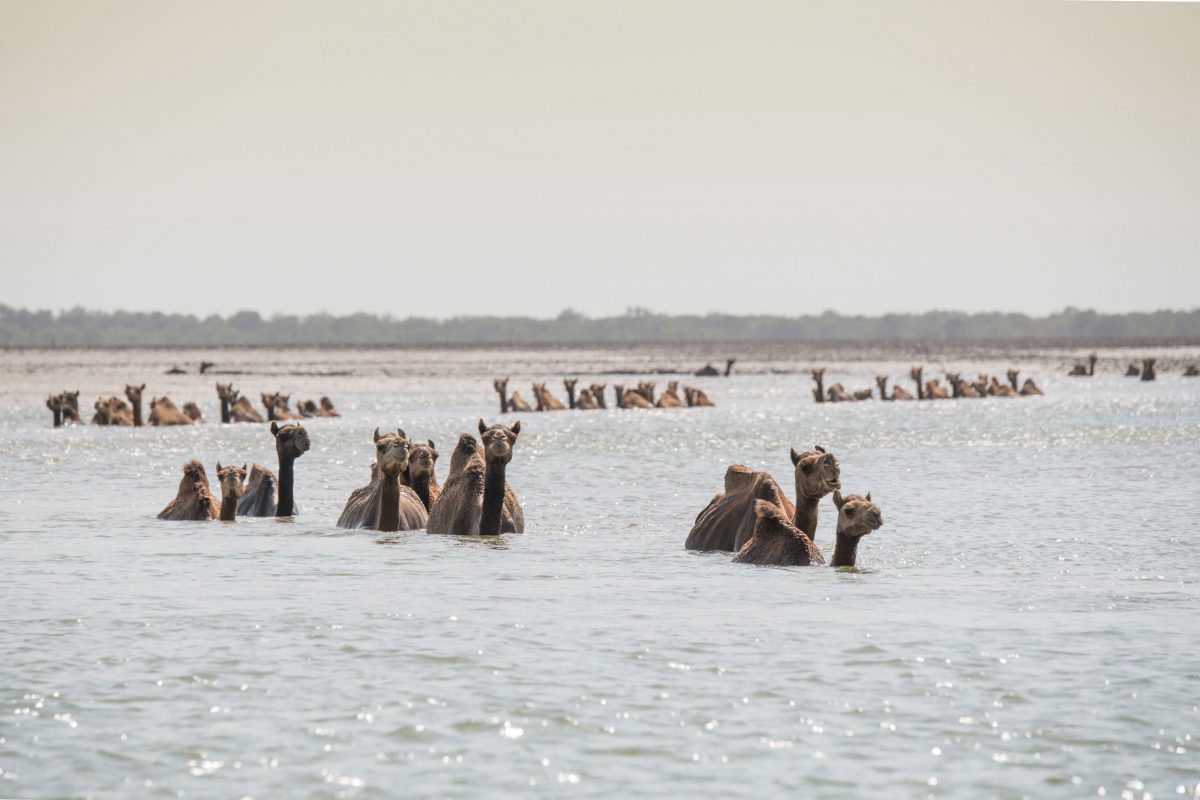
A herd of kharai camels wades and swims through a tidal channel in the Indian district of Kachchh. At times, kharais may stay on coastal islands for months at a time. But when there’s little rain, they return to the mainland every few days for water.
We wait, stuck in the shallows just a few meters from where we left. Half an hour goes by. An hour. And then the full herd emerges—an amorphous mass of beige legs and necks. Without hesitation, they stream into the sea, this time paddling toward us down a channel separating the mainland from a cluster of islands. Because of details lost in translation, and the fluid way people here seem to materialize and then disappear, I only realize the herd’s owner is on board the boat when he hoists his bunchy white dhoti and slips over the gunwale. Up to his waist in water as warm and milky as chai, he chants “he, he, he,” directing the animals to the deepest trench. The adults paddle purposefully past, just their heads and the very tips of their single humps still dry. A yearling, with a goofy tuft of long hair flopping over its small hump like a bad set of ’80s bangs, zigzags behind.
This is the kharai camel, a breed unique to this wedge of the world, named after the local word for “salty.” Its diet is dominated by the leaves of mangroves—salt-tolerant plants that, like the camels, straddle the line between terrestrial and marine. The animals munch mangroves and other salty fare along the mainland but also regularly swim up to three or four kilometers into the Arabian Sea to access island groves.
With bellies bulging after several days of feeding, the camels before us are now returning to the mainland to drink. One or two herders, known as maldharis, tend each group of kharais, guiding the animals across common lands and forest reserves to food or water, though these camels seem to know exactly where they’re headed. At the water’s edge, the kharais slip on the slick clay. Some stop and lift their tails, volleying golf-ball-sized turds into the water. Others stop and roll in the shallows, kicking and squirming like dogs rolling in stink. If not for the long arm of a cement factory’s jetty reaching into the sea and windmills on the horizon, this scene could have taken place generations ago.
Kharai camels slip and struggle in slick mud along the coast of Kachchh, but can readily swim across a flooded tidal channel to get back to the mainland for water.
A few years ago, the kharai didn’t exist—in the official sense. The maldharis of Kachchh (or Kutch), a vast sun-bleached district of Gujarat in the farthest westerly reaches of India, always recognized that the kharai was distinct from the region’s other camel, the Kachchhi (or Kutchi), but administratively, the camels were all Kachchhi. Sahjeevan, a local NGO focused on conserving biodiversity and supporting the livelihoods of pastoralist communities, was working on a camel conservation program around 2011 when staff learned about the kharai from herders.
To an inexperienced eye, the kharai looks like a slightly daintier version of the Kachchhi, though locals list a suite of differences: kharais have bigger heads and ears slightly bent at the tip; they’re typically a shade darker, have finer hair, and sport a smaller chest pad. Testing by a local university identified a genetic distinction between the kharai and Kachchhi, albeit a modest one. An animal group should have distinct physical features but doesn’t need to stand out genetically to warrant designating it a separate breed anyhow, the geneticist behind the study points out—a breed can also be defined by other variables, including functional or lifestyle differences, and even by its connection to a specific group of people. In other words, the kharai is special because the people here have decided so.
Sahjeevan and its allies lobbied for the kharai’s designation as a breed, and were approved in 2015. The framed registration certificate hangs like an award in the stairwell on a pastel pink wall at Sahjeevan’s two-story office in Bhuj, Kachchh’s capital city. At the time of the designation, Kachchh’s camel population tallied around 8,000, less than half of what it was a decade prior, and only a quarter of them were kharais. Sahjeevan estimates that today, only 1,900 or so kharais belong to 35 families in Kachchh. Populations in other parts of coastal Gujarat bring India’s grand total to under 5,000. More kharais live just beyond the border, in coastal Pakistan, though the populations don’t mingle.
Camels have been fixtures in India for hundreds of years. Maldharis traditionally sold male camels to serve as draft animals and transportation—the military in particular relied on them for patrolling the desert expanse that marks the border with Pakistan. But modernization has left India’s ships of the desert in a cloud of two- and four-stroke-engine exhaust; gas-powered vehicles have all but replaced them. By the time Sahjeevan had introduced the kharai to the wider world through its conservation work, many herders had already given up their animals, turning to labor jobs instead.
For the remaining kharais and their maldharis, the biggest limiting factor is mangroves, and access to them. The salty foliage constitutes 70 to 80 percent of what kharais eat—the animals only turn to a diet dominated by grasses in the winter, when herds head inland to deliver calves. Unfortunately for kharais, industry shares their predilection for the coast. Following a massive earthquake that rocked the region in 2001, a government eager for economic revitalization ushered in industrial development—cement factories, thermal power plants, port complexes, oil refineries, mines, and vast commercial salt operations plunked down and spread out in the kharai’s coastal path. Industrial development supplants mangrove habitat but can also kill the plants by cutting off natural water sources; by discharging chemicals, brine, and superheated wastewater; and through erosion associated with shipping and dredging. The state forestry department, savvy to the immense ecological value of mangroves, also bars camels from the remaining undeveloped areas and newly planted patches, fearing that the animals cause damage. And hypervigilant border security forces keep maldharis and camels away from some of Kachchh’s most productive mangrove forests in the north near the India-Pakistan border.

Globally, camels are considered multipurpose animals that provide meat, milk, and wool and have been used for drafting, transportation, border security, racing, tourism (plus, as camel expert Bernard Faye points out, the occasional beauty contest). In the coastal town of Mandvi in Kachchh, tourists can ride a kharai or Kachchhi camel along the beach.
The maelstrom of challenges has left supporters scrambling to navigate the forces working against kharais—to find a place for an old animal in a new world. The work is greater than novelty or nostalgia. Kharais and their Kachchhi cousins represent an increasingly rare lifestyle that is gentle on the landscape and inherently resilient, a lifestyle that the larger world, so caught up in extractive resource economies, can learn from. Camels—including the little-known coastal dwellers—have been significant players in the human story and may prove increasingly important for the future.
It was an affection for oddities and outliers that propelled me 15,000 kilometers across the world to meet the seafaring camel pre-COVID-19. Sahjeevan continues to work closely with camel-herding families and allowed me to join them on field visits with maldharis scattered throughout coastal Kachchh. Mahendra Bhanani, Sahjeevan’s camel program coordinator, whose passion for ecological justice permeates the language barrier and whose phone is rarely detached from his ear, leads our informal entourage, along with his assistant Mahesh Garava, a gentle millennial father and broad-smiled star of many selfies. Our driver is Rasiklal Gajara, a stern man who brakes for every bird that nears his windshield and visibly cringes at the pens and notebooks bouncing around his vehicle. My translator, Mirmamad Salemamad Sama, generally works as an English and math teacher at a school. As my intermediary to the kharai’s world, he also becomes my primary source of bemusement:
“I hear a bird singing—do you know what kind of bird that is?” I ask on the boat.
“There is no bird.”
“I hear a bird singing.”
“No. Birds come here in winter. There are no birds here.”
“But I can hear it. Can you hear it?”
“There are no birds.”
“Well, there’s a bird.” I point to a white bird beside the boat.
“That’s a flamingo.”
“I think that’s an egret.”
“It’s a duck.”
“You’re certain?” I hesitate. “It looks very much like an egret to me. But it is a bird.”
“Maybe you see an egret, but you hear a duck.”
No matter. I’ve come for camels, and there’s no mistaking them.
After we’ve waded to shore, we follow camel prints past the occasional dust-shrouded shrub for a kilometer or so. The mud squelches underfoot and grabs at my shoes, pitching me at one point onto hands and knees.
At a well, two maldharis let their buckets plunge meters down the long, gaping throat, siphon off some water, and strain to pull it up hand over fist before sloshing it into a trough. The camels huddle around, dipping and then lifting their heads high like slow-motion pump jacks, taking time to stare down their noses at the unusual foreigner in their midst. Drink. Lift. Stare. Drink. Lift. Stare. I stare back, trying to decide: regal or gangly? But just as they shrug off the constraints of a single ecosystem, the camels defy such a simple either-or characterization; they are both simultaneously. They hold their long necks with grace, but have lumpy, bony bodies perched upon knuckle knees; they blink through luxurious lashes framing anime eyes, but a cleft cinches their top lip up like a curtain rising over boxy teeth. As I stand among them, a female sashays by—a prima donna commanding the stage—pauses to tuck her knees together, and lets out a long, gurgling fart.
It’s fitting that the kharai, as a walking contradiction, is defined by the clashing perspectives people imprint on it. Scientists have just begun to study it in depth, and where science is absent, perception and opinion sometimes stand for verified truth. Maldharis know, for example, that the kharai’s coastal lifestyle is not merely circumstantial, it’s intrinsic to their well-being. Salt water cures the kharai’s wounds and prevents disease. A scientist I speak with from a camel research center in the adjacent province of Rajasthan says the opposite, claiming that moisture in the coastal region allows microbes to fester, exacerbating kharais’ skin problems and undermining their health. Maldharis say that kharais always prefer mangroves over other fodder. And without mangroves to feed on, kharais produce less milk and fewer offspring, and their health suffers. Yet France-based international camel expert Bernard Faye has studied camels in coastal regions elsewhere in the world and has found that mangroves are generally “very poor fodder,” lacking in some key nutrients. In Djibouti, where he conducted a study about 25 years ago, pastoralists told him that a camel diet rich in mangroves limited the animal’s growth and shortened its life expectancy. Yet in Kachchh, kharai camels, a local authority tells me, live significantly longer than Kachchhi—25 years compared to 17 or 18.
Perhaps the most heated point of debate is whether the kharai is an ecological menace or a key contributor to the coastal ecosystem. The kharai is often accused of trampling seedlings and feeding on growing buds, leaving Avicennia marina, the dominant mangrove species here, bushy and stunted. Not so, say the kharai’s advocates—camels give as much as they take, sprinkling fertilizing dung and urine into the nutrient-starved desert coastline. And their footprints create microcatchments that can shelter sprouting propagules, helping the seeds survive.
When they’re not swimming between islands, kharais do a lot of slurping and cud chewing.
To Pankaj Joshi, an ecologist at Sahjeevan and the acting director during my visit, the idea that herders and their animals contribute to ecological destruction is illogical. They existed in balance with the ecosystem long before industry altered the landscape. Consider the wisdom of gardening, he says: to promote a healthy crop, you must thin young plants; to enable trees to grow big and produce fruit, you must prune them. Camels provide that service. “More eat, more grow,” one maldhari puts it. In Joshi’s experience, the biggest trees are always in kharai grazing areas.
A challenge for kharai advocates now is to root out the truths. Sahjeevan never discounts traditional knowledge, Joshi says, but instead tries to understand it through science. “There are many perspectives,” he acknowledges, holding his hands apart like two posts of a spectrum. “There is the scientific perspective,” he indicates with his left hand. “And there’s the pastoralist perspective,” gesturing with the other. “I’m right in the middle. We bridge the gap.”
Despite the apparent wariness that some government departments have toward camels, Gujarat’s animal husbandry branch plus academics and partner organizations were quick to embrace the kharai and kick-started new studies and initiatives following the breed designation. And from January 2018 to March 2020, India’s National Bureau of Animal Genetic Resources, which is mandated to boost the population of any livestock breed that dips below 10,000, ran a multipronged conservation initiative, which included selective breeding, providing veterinary care to reduce mortality, and cryopreserving kharai tissues. The interventions have helped the kharai population creep in the right direction.
If the population manages to keep growing, the question remains, how will all of those kharais fare in a region that has become less hospitable to them? They’ll live on the fringe in more ways than one—and the fringe is a precarious place to be.
On another day, early morning sun still burnishes the land bronze as we roll to a stop at the sparse village of Dragavandh, a cape of dust fluttering back to earth behind us. Nearby, kharai camels wriggle their lips around trees, plucking leaves, as they make their way to the sea. A gaggle of young girls, each with two long braids and matching red frocks scatter when I make eye contact. They peer around the corners of two traditional reed homes called pakkhas built side by side where the family of Shermamad Sale Jat and Nashibibai Shermamad Jat—better known as Nani, for grandmother—live. The village’s other houses, spaced out on a plain of hard-packed dirt near a cistern, are a similar size and shape but most are made of manufactured blocks.
Nani ushers us onto a blanket on the floor of the larger one-room home and pours tea into saucers. The sugary brew is a social requirement and daily ritual. For a few moments, the room fills with slurping noises as everyone drinks from the shallow dishes balanced on their fingertips. Outside, a tiny black-and-white goat tied to a post strains and bawls pitifully, hopefully unaware that its hours are numbered. Herders in India are unique in that they typically do not eat camel meat—but the little goat will not be so fortunate.
Behind Nani and Shermamad, shelves laden with tin pots stretch the length of one wall. A small cube fridge runs on solar power in the corner; as we chat, children wander in to take a packet of masala-flavored snacks hanging from a plastic strip beside it. A three-year-old granddaughter plunks down, sullen, in Nani’s lap.
Two communities herd kharai camels in Kachchh: the Fakirani Jats, including Nani and Shermamad, who follow the mystical tradition of Sufism, which has Islamic roots; and the Rabari people, who are Hindu. Despite different religious beliefs, the two communities are closely connected—they welcome one another into their sacred spaces and rituals, honor one another’s beliefs, and sometimes name children after one another. Later, when I meet Sandeep Virmani and Sushma Iyengar, two of the intellectual powerhouses linked to Sahjeevan who both have extensive and Nobel Prize–worthy records of serving India’s marginalized communities, they explain that legend states that the friendship between Rabari and Fakirani Jat peoples can be traced back to a saint named Savlapir. Two Rabari brothers were fighting over a single camel left behind by their father and turned to Savlapir, revered by both Muslims and Hindus, for guidance. The saint allowed one brother to leave with the disputed camel and told the other to walk away. If he didn’t look back, camels would multiply behind him. When the man finally gave in to curiosity and broke the spell, he found a legion of camels trailing him. He rushed back to the saint, fretting about how to care for so many animals. Not to worry, the saint replied—his followers, the Fakirani Jats, would help. Ever since, Fakirani Jats have both tended their own camels and assisted Rabaris with theirs, Iyengar says. “And both of them are kind of completely tied in this bond.”
Traditionally, Fakirani Jat maldhari families were fully nomadic. They’d pack up all of their belongings, including their home, and would relocate as a family unit, always seeking resources for their animals across the common lands, while Rabari families would often send only one maldhari out while everyone else stayed home. After India and Pakistan split in 1947, the border limited pastoralists’ movements. With the additional challenge of mangroves becoming fragmented, many maldhari families have become sedentary, especially in the past 30 or 40 years, explains Virmani. Nani and Shermamad’s family, however, has been rooted in their village, where their household is the only one that raises camels, for generations; there are plenty of good mangroves nearby, close to the Pakistan border, so they don’t need to travel far. Border security forces sometimes hassle Shermamad, but if he gets stopped, he pretends the camels don’t belong to him.
The pastoralist lifestyle is poorly understood by broader society, Iyengar notes, because pastoralists live on the margins—environmentally, socially, and politically. That realization inspired her a few years ago to create an exhibition that debuted in Delhi showcasing India’s pastoralist communities, which was instrumental in raising the kharai’s profile outside of Kachchh. She called it Living Lightly.
Pastoralism, she points out, is an increasingly rare lifestyle that honors and is compatible with the environment—a holdover from a time when most emissions were from fires and flatulence. By Virmani and Iyengar’s estimation, it is one of the few economic pursuits in the world that doesn’t destroy the environment. As humankind as a whole busily overexploits the resources around us, Kachchh’s camel herders are vested in maintaining intact ecosystems, and their minimalistic lifestyles are an antidote to the commercialism that drives so much destruction.
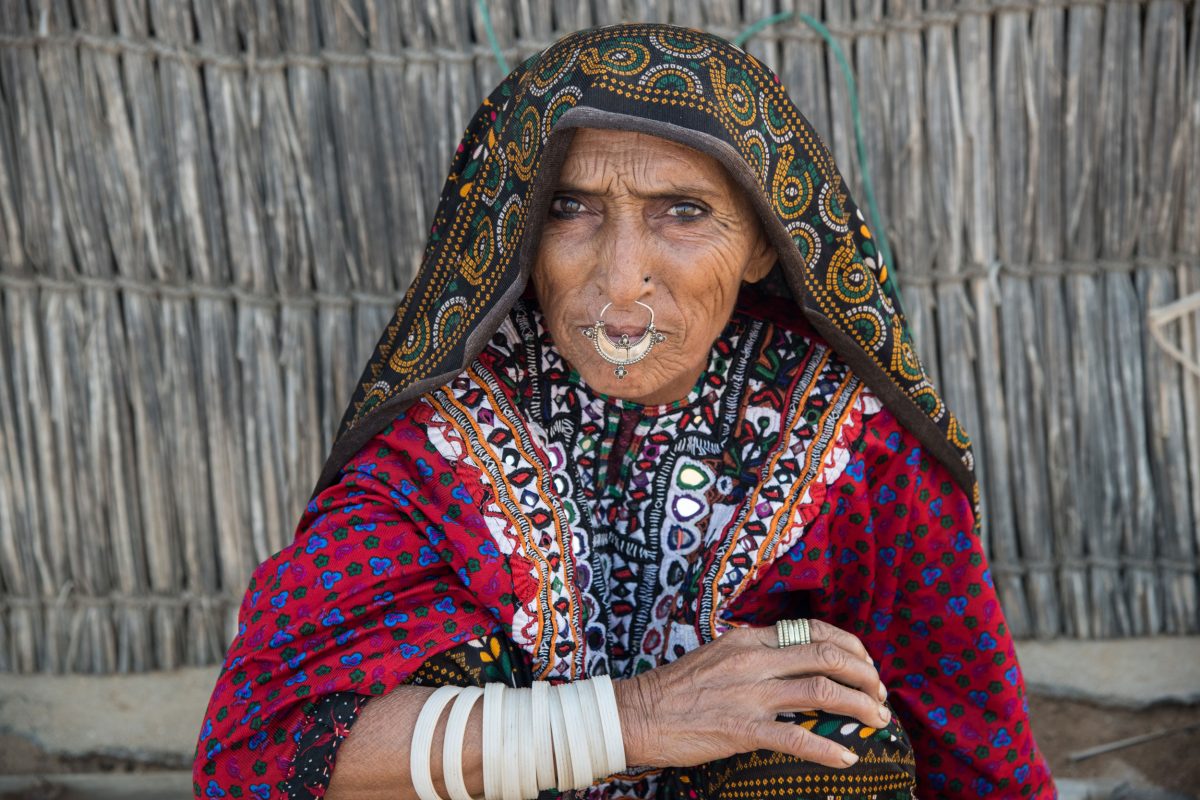
Two communities herd kharai camels, the Fakirani Jats (which is the community this villager from Dragavandh belongs to) and the Rabaris.
Their way of life also blurs the lines between culture, economics, politics, and the environment, says Virmani. “Today’s world is so obsessed with patenting knowledge and then using it for economic ventures; here’s a life plan which completely subsumes the economy as only a byproduct of a lifestyle.” When market economies crash and burn (which, perhaps, the world is seeing now) we can turn to pastoralists for insights into a more sustainable and holistic way of operating in the world.
While other maldharis I meet lament the fact that market forces and industrialization of the coastline have made their lifestyle more difficult to maintain, Shermamad and Nani are upbeat. “There’s no better life than maldhari,” says Nani. They would like 50 more kharai camels. Because, in a climate that’s notoriously tough on living things, the kharai offers security.
My trip falls during monsoon season, but the landscape beyond Shermamad and Nani’s threshold is parched and rutted with the ghost of rainfall past. The region has not seen a single good rainfall for months. At one point on our journeys through Kachchh, my translator will gaze up at the blazing sky and muse, “Sometimes in monsoon season, there may be cloud in the sky and we are thinking it will rain. But no rain.” I’ll check the weather for weeks after the trip and see nothing but the yellow symbol for sun. Garmi, we all agree, bonding over the searing weather. Hot.
Kachchh is changing, V. Vijay Kumar, the director of the Gujarat Institute of Desert Ecology (GUIDE), explains when I later meet him in Bhuj. Historically, rainfall peaked in July and August. Now the peak comes weeks later. When rain does arrive, it’s infrequent and torrential. Seeds sprout with the first pulse of rain, but then die without supporting moisture. And when the grasses flounder, weeds such as an invasive, thorny plant called ganda bhava, rush in. Temperatures in the region are ratcheting up, which means moisture that does fall is more likely to evaporate. And increasingly strong winds can whip away dry soil.
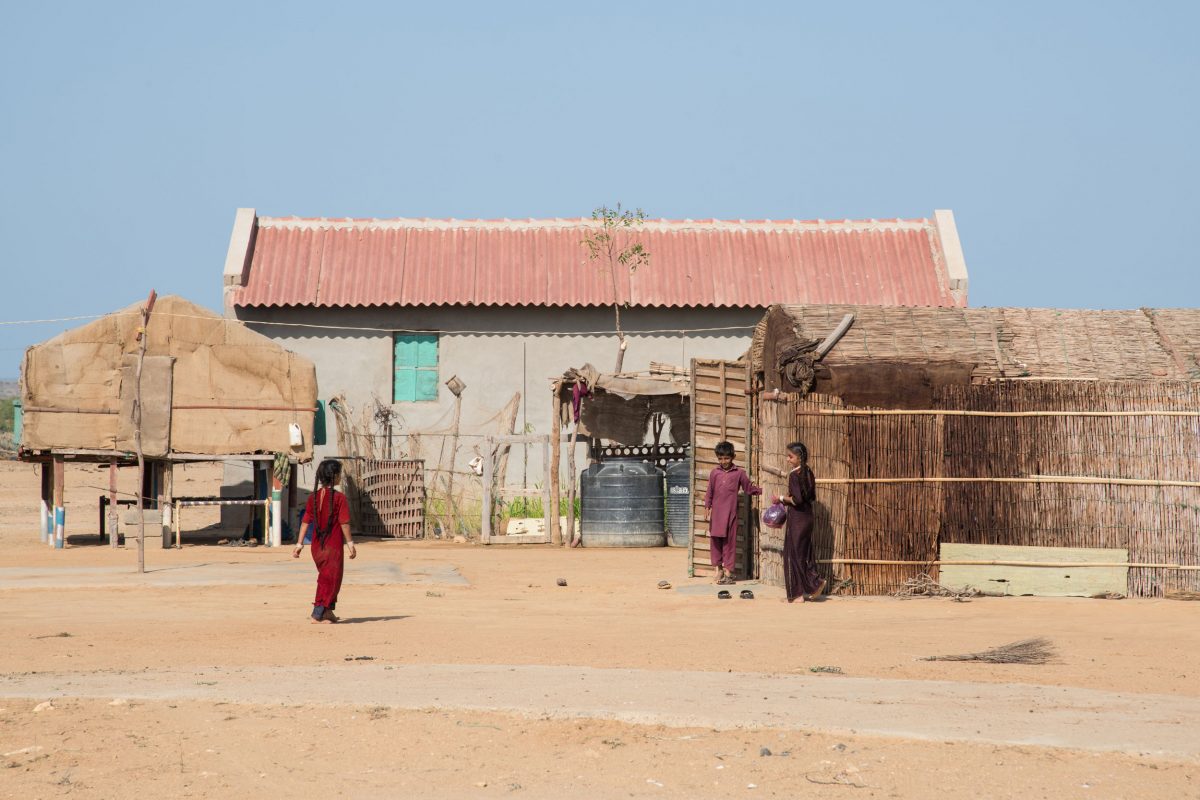
Traditionally, many maldharis were nomadic, but some families have chosen to become rooted in one place in recent years, as camel grazing areas have become more restricted. Here, children gather in the village of Dragavandh.
Kachchh used to see a five-year cycle—imperfect, but a general trend—of three years of drought, one normal year, and one year with heavier rainfall, but the sequence has become erratic. “Earlier, local villagers used to predict rainfall looking at animal behavior, bird behavior, and at seawater trends—like the color of seawater—and used to be able to say, ‘this year would be a good rainfall year, this year would be a drought year,’” Kumar says. They could adjust agricultural practices, diversify their sources of income, or—in the case of maldharis—migrate in response. Now the shifting conditions defy prediction.
In uncertain times, kharais have an advantage. They’re relatively resistant to drought because their fodder is less rain-dependent than other livestock’s. Kharais make life easier in other ways, too, Shermamad says: they find water and food more readily than buffalo or Kachchhi camels, and can be managed by fewer herders. Other maldharis echo that sentiment—despite all of the challenges, kharais are still a better bet than other livestock. They are dependable—like a vintage 1970s harvest gold appliance that keeps on running even though its base is cracked and electrical wires frayed.
“I take care of them as we take care of our own children,” Shermamad says. “The herd is never divided, always stays together—stays together like a family.” While Shermamad’s positivity seems atypical, his affection for his animals is common; other maldharis I meet talk about their animals with the same fondness. They were, after all, made for each other.
From an outside perspective, the prospect of losing a domesticated animal may not hold the same gravitas as wildlife extinctions, but the bond between maldharis and their animals runs deep, Iyengar says. In one version of an origin story, camels were created by the goddess Parvati, who shaped them out of mud as five-legged creatures and demanded her husband, Hindu deity Lord Shiva, breathe life into them. Shiva obliged, but first pushed the fifth leg into the animal’s body, creating its hump. The camels were soon wandering aimlessly, so Shiva sloughed sweat and dirt from his body and used it to shape the first two men.
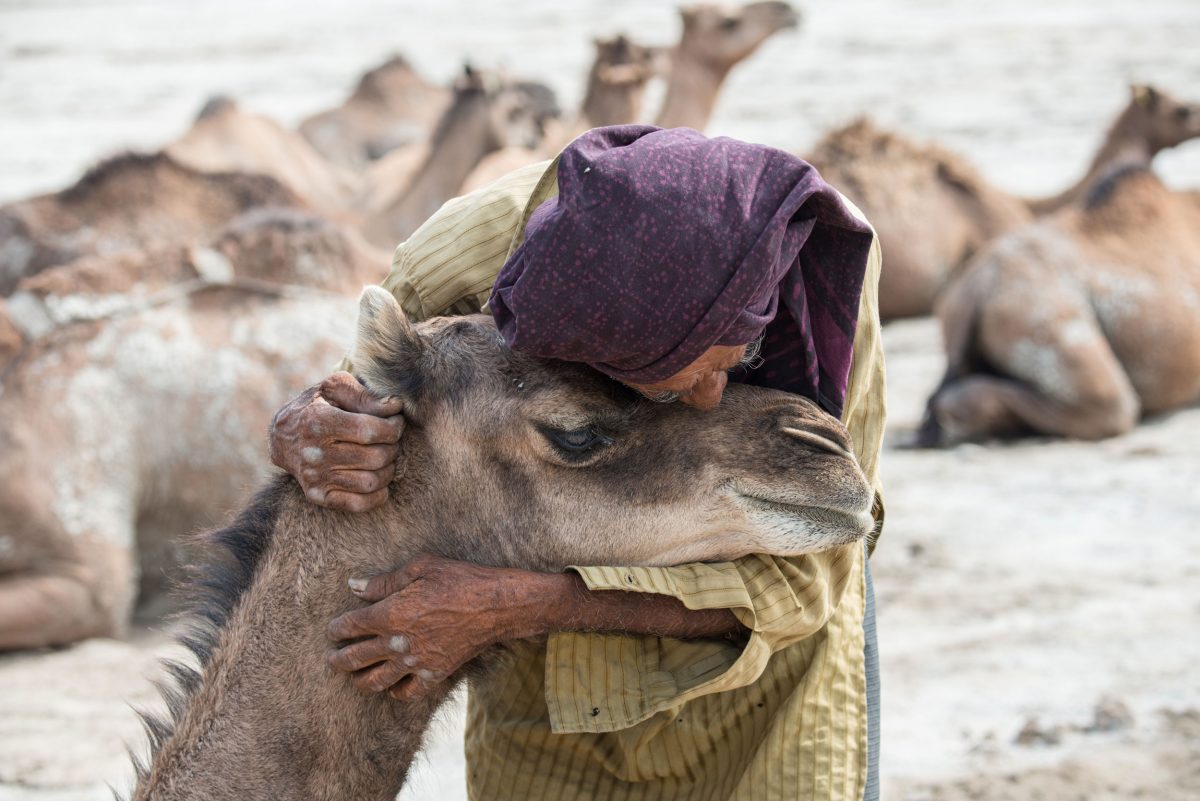
A maldhari, who has taken care of camels since he was knee height, cuddles one of his animals on the periphery of a major salt-production enterprise that now dominates the area.
The alternate origin story, pieced together by geneticists, archaeologists, and zoologists, is equally extraordinary. The first member of the Camelidae family arose on the other side of the world, not from clay but from a bud on the evolutionary tree. Poebrodon, generally believed to have been the earliest true camelid, appeared in North America about 45 million years ago and was likely bigger than a rabbit, smaller than a goat. It eventually diversified, giving rise to dozens of genera—some early camelids had the physique of a gazelle. Some bore the long snout of a crocodile. Others had an extremely long neck, like a giraffe, or were monstrously large.
Sometime around 17 million years ago, camelids split. The ancestors of alpacas, llamas, guanacos, and vicuñas eventually funneled down to South America. By then, ancestors of camels had ventured north and spread across Beringia, heading into Asia, Europe, North Africa, and the Arabian Peninsula. After a few million more years, an animal called Paracamelus finally gave rise to one- and two-humped camels. Today, three species of camel exist: the handsome, shaggy two-humped Bactrian; a little-known and critically endangered two-humped wild species; and the one-humped dromedary, which is the category the kharai falls into. Sources don’t agree on when the dromedary finally sauntered into India; they could have arrived more than 2,000 years ago as travelers on the Silk Road, or as recently as 600 years ago coinciding with a boom in and expansion of the domesticated dromedary population in the 15th century.
As remarkable as seafaring camels seem, it’s possible the kharai’s saltwater ways are rooted deep in its ancestral memory. They are the descendants of early dromedaries that lived along the Arabian coast. While the paleontological record is missing many pages, findings of bones suggest that those wild beasts favored the shoreline where they could find the most fodder and lots of salt, which is thought to be crucial to their digestive health. They may have fed along the sea but learned to retreat to the desert for safety, suggests veterinarian and conservation geneticist Pamela Burger of the University of Veterinary Medicine, Vienna, in Austria. Eventually pressure from human hunters or other predators may have forced them to give up the coast and become full desert dwellers.
Whether those early dromedaries swam through the sea is anyone’s guess, but when I ask Bernard Faye, the France-based camel expert, about the kharai’s aquatic ways, he points out that any camel can swim—despite the erroneous claim floating around that the kharai is the world’s only swimming camel. In the United Arab Emirates, racing camels train in a swimming pool. In the Canary Islands, camels regularly swim between islands. “I can tell you, they swim very well,” says Faye. “Of course, if [a camel is] not accustomed to do that, probably the first time it will be difficult for them,” he adds. “It’s like for you and me—if you don’t go in the water you will never swim.” Kachchhi camels, for example, fear water, Sahjeevan’s Bhanani insists—they will only go in if they’ve been raised among kharais.
It was roughly 3,000 to 4,000 years ago when humans began capturing and domesticating dromedaries on the Arabian Peninsula. The process may have taken hundreds of years. By then, humans were already adept at manipulating nature. We tamed dogs at least 10,000 years ago (possibly even 30,000 years ago), domesticated the goat 8,000 to 9,000 years ago, and had conscripted Bactrian camels for our cause elsewhere 5,000 to 6,000 years ago. People bred and exploited camels as draft animals and for their milk, meat, and wool. One pair of archaeologists note that a key role of dromedaries in southeast Arabia was to shuttle fish from the coast to the interior.
For a while after domestication, 1,000 to 2,000 years, two species of dromedaries existed—the wild dromedary and the smaller domesticate. Eventually, wild dromedaries disappeared, the last members likely absorbed into domestic herds. The one-humped camel had become, and would remain, the dominion of humans.
At a Fakirani Jat encampment, a skittish 15-day-old kharai calf bolts when a visitor gets too close, wrapping itself around the stake it’s attached to like a sentient tetherball. Nearby, two adult females rest on the ground, each with a calf only days old pressed to their side. The mothers alternate between munching on cut mangrove branches and letting out low, growly Chewbacca-like moans that a Hollywood sound designer might impose on a brontosaurus.
This is what camels sound like—really. Recording by Shanna Baker
Though his herd is growing, the owner explains he might sell his animals and turn to labor jobs to support his family instead. Mangroves have just become too hard to come by. Commercial salt production has taken over much of this area surrounding the Deendayal Port, the region’s major conduit for international maritime trade, which encompasses 1,000 square kilometers. While development in coastal Kachchh continues to rise, regulations exist to prevent further damage to mangroves—there’s even evidence from satellite imagery that total mangrove cover has actually increased in recent years—yet foraging areas remain more fragmented, sparse, and harder to access than ever before.
The challenges maldharis are confronting have made India an anomaly—one of the only camel countries in the world where the camel population is decreasing. Worldwide, camels tally roughly 35 million and are increasing at an average of about 3.5 percent a year. Because, as India struggles to make space for camels, other nations are recognizing how much they might need the animals in their rapidly changing environments.

Adam Abdreman stands with one of his new kharai calves, just a couple of weeks old. Though his herd has been growing, he feels it’s only a matter of time until camel herding becomes untenable.
Camels have adaptations that allow them to thrive where other livestock falters—not just in desert heat, but also in frigid cold. After the discovery of bone fragments from an ancient camel tibia in the Canadian Arctic in 2006, which extended the range of historical camels 1,200 kilometers north, the researchers who published the findings pointed out that the camel’s wide, flat feet were likely as efficient on snow as they are on sand. And their humps—which, contrary to popular belief, are not portable water jugs, but fat deposits—may have helped with heat retention in a frosty environment. Today’s camels are as comfortable at 5 °C as they are at 40 °C. In hot desert environments, they conserve water by regulating their body temperature to limit sweating, produce super-concentrated urine, and reabsorb moisture through mucus in their nostrils. Still, they can cope with significant water loss—up to 25 percent of their body weight, a scenario that would be fatal to a non-desert mammal. One study suggests camels have another desert superpower: they’re genetically adapted to tolerate dust.
In regions that are experiencing increased drought and aridity, camels can replace cows, sheep, and other less-hardy livestock. In the past 20 or 30 years, camels have become new fixtures in Nigeria, Tanzania, and Uganda, for example. They are sources of milk, meat, and wool, and are used for tourism and racing. “No other domestic animal is able to provide as many variable services to human[s],” Faye wrote in a 2015 paper.
In a shifting climate, the camel offers another advantage. It has the potential, Faye says, to “combat desertification.” While other livestock such as cows and sheep eat only grass, and goats are restricted by their height, the camel with its long neck can nibble on anything from grass and straw on the ground to the sharp spines of a bush or to leaves in the high branches of a tree. That reach reduces the potential for overgrazing, says Faye. Camels can digest very tough plant matter—such as mangrove leaves and twigs—and can thrive on less food than a cow, exerting less pressure on the ecosystem. A Holstein (North America’s signature dairy cow), for example, might need 50 kilograms of food per day, whereas a camel needs just 20 to 25 kilograms.

A camel’s soft hoof is gentle on the earth—one of several advantages the animal offers over other livestock. Here, a Kachchhi camel strolls across a farmer’s field. Camels are often invited to visit fields to deposit fertilizer.
And the camel has no hoof, Faye notes—its soft foot is gentle on the earth, unlike a hard hoof that can destroy grass. Plus, the camel’s ability to go for days without drinking means it can roam a much greater distance, minimizing the amount of damage it does in any one area. Sheep, cows, and goats, in contrast, must drink at least every two days, so they have a greater impact in a concentrated area around a watering hole.
As climatic shifts and degradation of the landscape make life less tenable for other livestock, perhaps the camel’s glory days are yet to come. This is why, when Faye ponders the camel’s future, he remains optimistic. “Animal of the past, or animal of the future, that is the question,” he says. “… I say it’s an animal of the future.” Conservation geneticist Pamela Burger, a collaborator of Faye’s, agrees that the camel may become increasingly important. Yet, “in India,” she says, it is still widely considered “an animal of the past.”
Sahjeevan and its allies are trying hard to change that, for both the kharai and the Kachchhi. And they have a plan.
A maldhari named Manda Khima unlatches a woven sack covering one of his camel’s udders and coaxes a hard stream of milk into a tin pot. He offers me some. The taste is familiar, like cow’s milk, but more intense and a little salty. It’s thick and warm and coats my tongue, leaving an aftertaste that’s hard to expunge. This frothy white elixir sustained maldharis and their families through generations. For them, it’s unparalleled in significance—there have been times when maldharis have relied on it entirely for sustenance, including during the COVID-19 pandemic—and it may now be their greatest economic hope.

Selling camel milk has emerged as the maldhari’s best chance of maintaining a traditional livelihood for the long-term. Historically, selling camel milk was considered taboo.
Just behind us, the steel fortress of a power plant looms, and a wall topped with barbed wire separates us from the herder’s home village. A second power plant hems the village in from its other side. To access traditional kharai grazing lands, Khima must show identification to a guard and walk his animals through alien territory, over bridges and freshly laid roads and the shadows of exhaust towers.
A few years ago, faced with the impacts of industrial development and waning demand for camels, the future of camel herding here and throughout Kachchh seemed particularly grim. Sahjeevan needed solutions—fast. The team—sensitive to the inextricable relationship between economics, culture, and the environment—understood that to save the breed, they first needed to protect the livelihood. Only if maldharis are financially secure and unified as a group can they fight to preserve the ecosystems they rely on. “Ultimately,” Ramesh Bhatti of Sahjeevan says, “we came to the conclusion that only the milk of the camel is the way to save the camels.”
Sahjeevan blazed forward, navigating all sorts of obstacles, including the fact that the national government didn’t consider camel milk fit for public consumption. Today, Kachchh’s camel milk, a mix from both kharais and Kachchhis, is collected into vats and eventually transformed into domestic products such as chocolate bars, powdered milk packets, and lotions. Camel milk itself has recently debuted as a commercial product in a few cities. The initiative has given maldharis new direction—a few who left for labor jobs have even returned to camel herding, Sahjeevan staff explain—and production is ramping up. The push comes at a fortuitous time—just as interest in camel milk for its medicinal potential begins to bubble over. Advocates make bold claims: some say it can inhibit cancer and tuberculosis, cure malaria, prevent anemia, and have therapeutic value for autism. Some studies also hint that camel milk could help control diabetes and high blood pressure.
Iyengar and Virmani have helped Sahjeevan champion the camel milk initiative, but behind the scenes, they wonder if the commercial program will swell and morph and one day change the community and way of life they wish to safeguard. As the market takes off, there’s a risk, for example, that milk will be diverted from women and children; that nomadic families may become sedentary around a collection point; or that maldharis will outsource their work, losing their own deep connections to the land. They hope to ameliorate some of those issues by working with communities to create artisanal camel products.
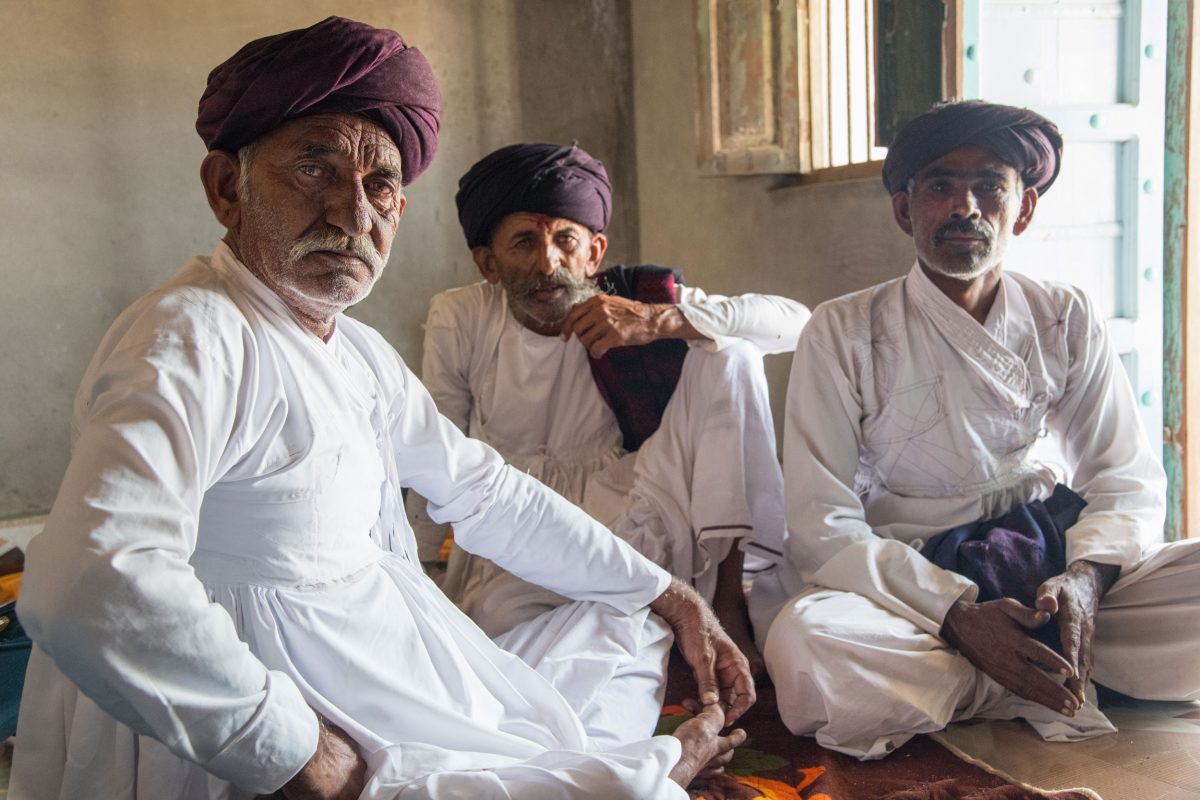
Maldharis from the Rabari village of Tundavandh linger after a meeting with representatives from Sahjeevan, a local NGO, about commercial camel milk production.
As we philosophize about the future, I also wonder what’s in store for the animals themselves. Will the challenges maldharis face in the grazing lands and the financial incentive to get milk to market more quickly and on a regular basis lead them to one day confine their animals to enclosures?
Elsewhere, such as the United Arab Emirates, some camels are already confined to farms as demand for camel products grows. The big question for camel scientists, says Faye, is what effect the shift to confinement will have on the animals. Without the ability to roam great distances, how will their metabolism be affected? How will the milk and meat change? He believes confinement has the potential to fundamentally alter camels. In 50 years or so, camels reared in farms may be different beasts, he predicts. “You cannot now put a Holstein in the forest of Europe anymore—it won’t survive,” he offers as an example. “We change the animals. We can regret it, but it’s like this.”
Already he has seen one impact of captivity on camels in Saudi Arabia—obesity because of overfeeding. “They have a big, big hump. Very big hump.”
That captive approach to camel rearing is not likely to happen in India, Virmani and Iyengar say. The tradition of free access to common lands where camels can roam widely is still strong, despite the myriad obstacles. And any maldharis I ask about keeping camels in captivity wave their hand at the question, saying they’ll sell their animals before accepting the fate of a farm.
V. Vijay Kumar of GUIDE, for his part, would like to see a shift to middle ground; he proposes that the best way to support the kharai while also protecting mangrove habitat is to develop policies to manage grazing, designating certain mangrove stands for livestock to graze in while keeping the animals away from others.
In the meantime, as the milk-product industry unfurls as an economic lifeline for maldharis, Sahjeevan is trying to secure better access and rights to existing mangroves for herders by invoking regulations for traditional land within Indian law. They and their partners are also helping maldharis police unsanctioned destruction. In early 2018, when they found out that a commercial salt company was illegally clearing mangroves in the Deendayal Port area, a camel breeders’ association affiliated with Sahjeevan called Kachchh Unt Ucherak Maldhari Sangathan managed to get a court-ordered cessation. The salt company was ordered to reopen the creek system a few months later. But that wasn’t the end of the story.
At the edge of a vast tic-tac-toe grid of salt ponds, Bhanani pauses beside a trench gouged into the soft earth with the deep bite marks of a machine, his expression grim. “Mangroves murdered by JCB [excavator],” he says in English. This is the same area where the salt company was caught destroying mangroves before, and workers are at it again. Two days before we came, they began digging up the earth, creating a dike wall that blocks a freshwater creek and will eventually choke out mangroves.
“It’s easy for them to destroy, hard for us to repair,” Bhanani says. “We will not take rest until it’s stopped.”
Behind us, saltwater ponds go on for many hectares—some peppered with tiptoeing flamingos, others a vibrant toxic-looking red from algal growth, others marked with the leafless skeletons of dead mangroves. The living mangroves I see interspersed around them are short and sparse, but Bhanani says at least 300 local kharais, as well as 150 others that migrate from elsewhere in Kachchh, along with buffalo, goat, and sheep, depend on this area for survival. (Other livestock can eat mangroves, he says, but herders must rinse the leaves with fresh water first.)

Fresh gouges from an excavator employed by a salt company in a region that kharai camels depend on are indicative of the challenges maldharis face in securing fodder.
Ayub Amin, a Fakirani Jat maldhari whose family lives at the edge of the saltworks, lights a bidi cigarette and shrugs. “It’s difficult for us, but what can be done?” He has been a part of this landscape for all 54 years of his life and has watched the mangroves his family depends on dwindle for the past 20. “Every year, more and more destruction. The company owners don’t care for us, or our camels.” He’s hopeful that selling camel milk will be sustainable, but he and his family members are considering decreasing their herd and turning to labor jobs instead. They would only do so reluctantly—going from owners to workers holds little appeal.
Despite the seemingly endless litany of challenges maldharis face, Iyengar, Virmani, and all the committed people of Sahjeevan hold tight to the belief there is a future for camel pastoralism in Kachchh. Because, Iyengar says, above all, maldharis and their animals know how to be nimble—they know how to keep moving. She also believes the world is coming around to recognizing and celebrating the inherent strength and resilience of animals like the kharai that have persisted for generations. Though pastoralism faces immediate challenges, “for me,” she says, “the reality is that it could be our future.”
At the salt pond, the original five—Bhanani, his assistant Mahesh Garava, driver Rasiklal Gajara, Mirmamad Salemamad Sama, and I—pile back into the vehicle along with Amin and his cousin. As we set back out over a rutted dike wall between salt ponds serving as a road, Amin’s cousin points to his camels in the distance. His brother, who normally tends to the camels, is unwell today, so his animals have fanned out to look for food. They’ll return to the village on their own in a couple of days’ time, he says. Though the landscape shifts around them, kharais still know how to navigate this transformed landscape.
On the dike road, we pass an excavator, gnawing into one of the ponds. Its operator looks up, raises a hand in greeting. For a moment, the machine is perfectly juxtaposed with the long line of camels in the distance, the animals cast vintage harvest gold as the sun dips behind them.
The Link LonkSeptember 22, 2020 at 02:05PM
https://ift.tt/3iS7LVT
Where Camels Take to the Sea - Hakai Magazine
https://ift.tt/2CoSmg4
Sea
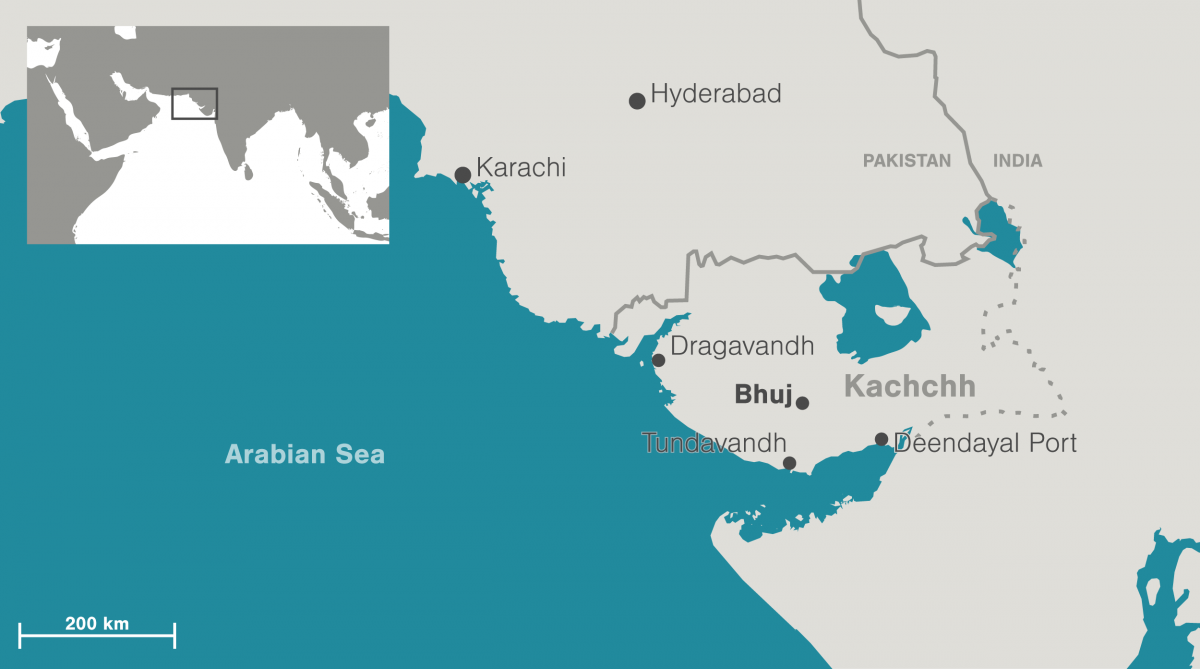


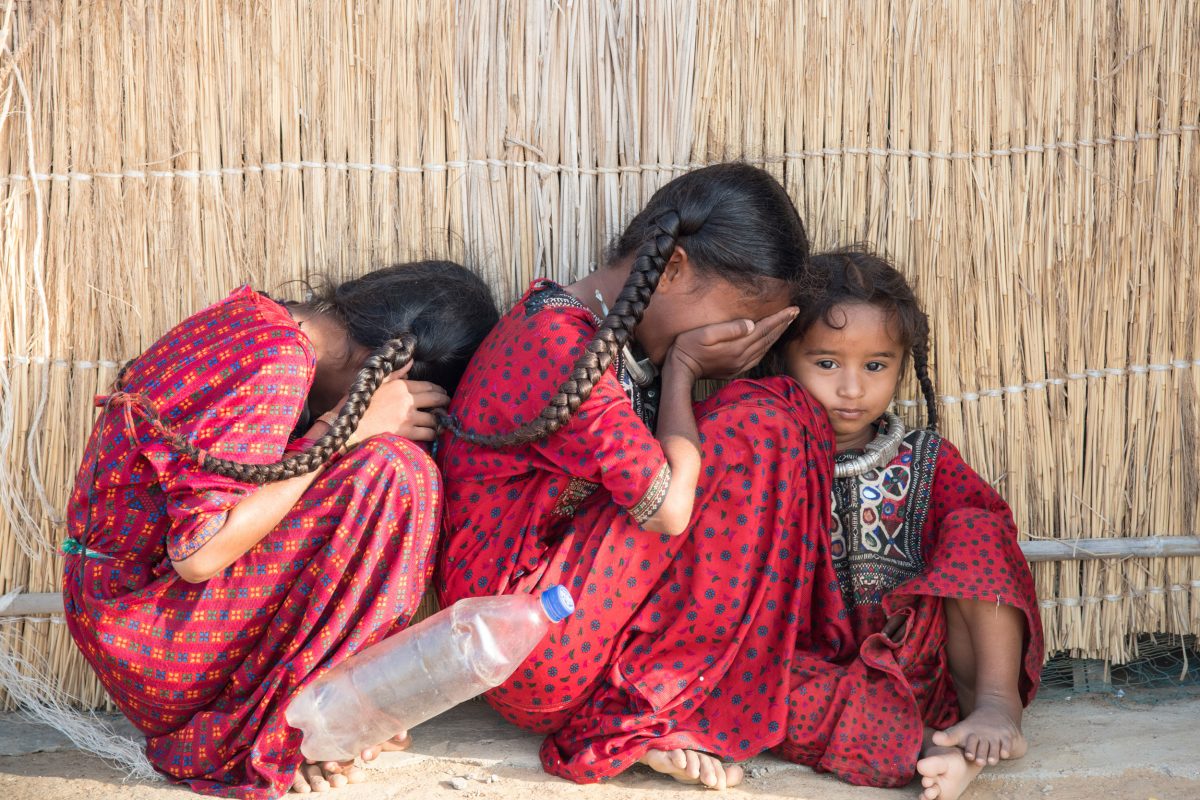
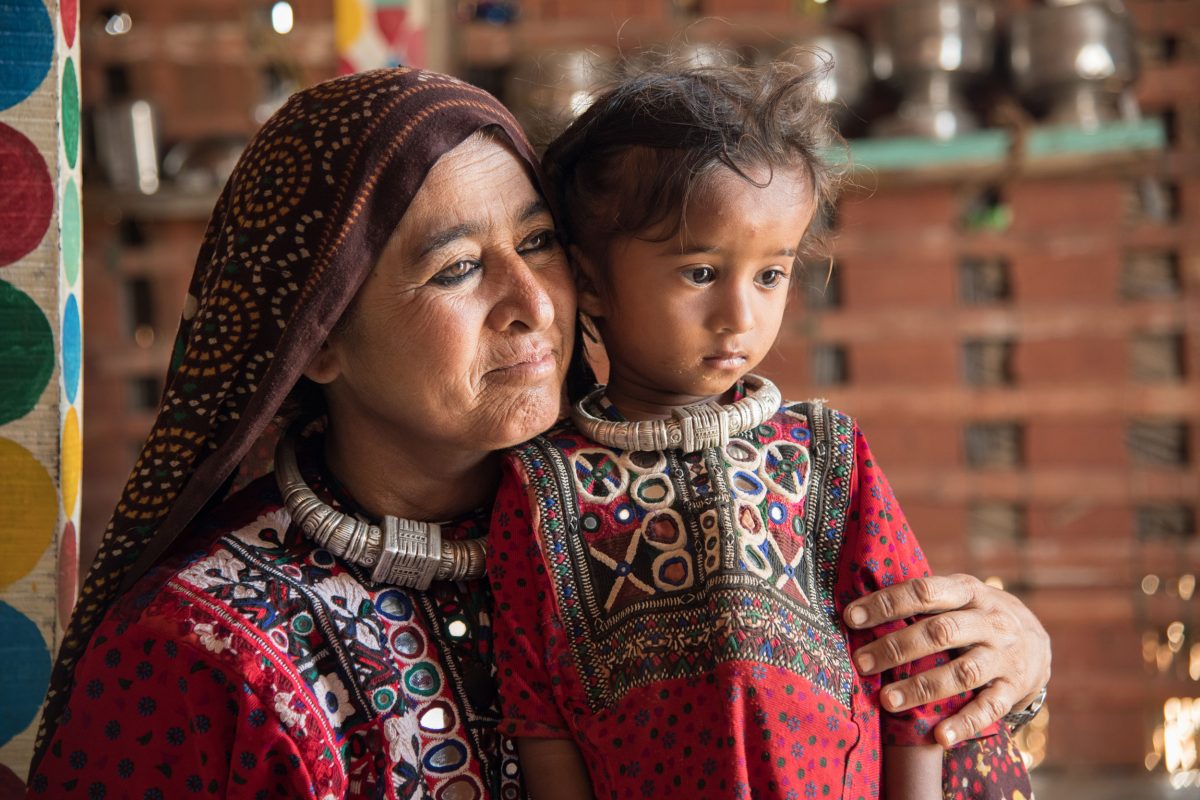
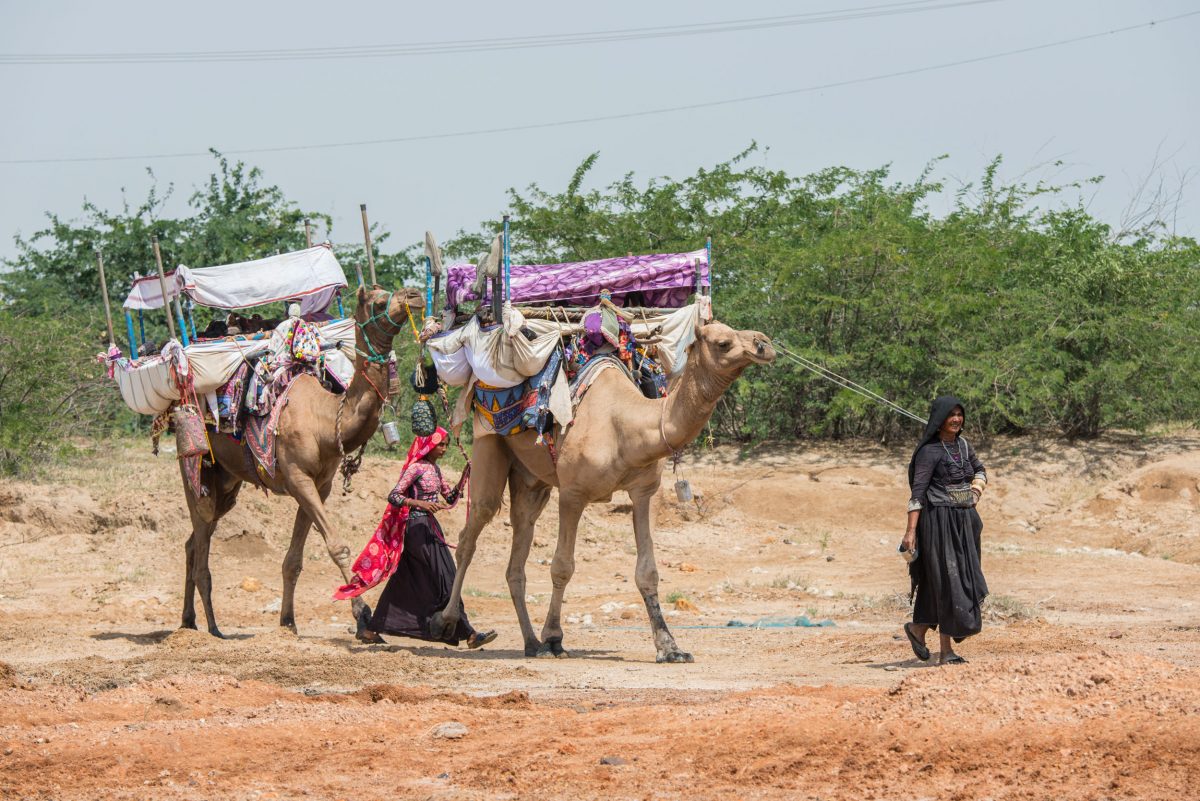
/cloudfront-us-east-2.images.arcpublishing.com/reuters/CZF6NULMVVMEXHOP7JK5BSPQUM.jpg)
No comments:
Post a Comment